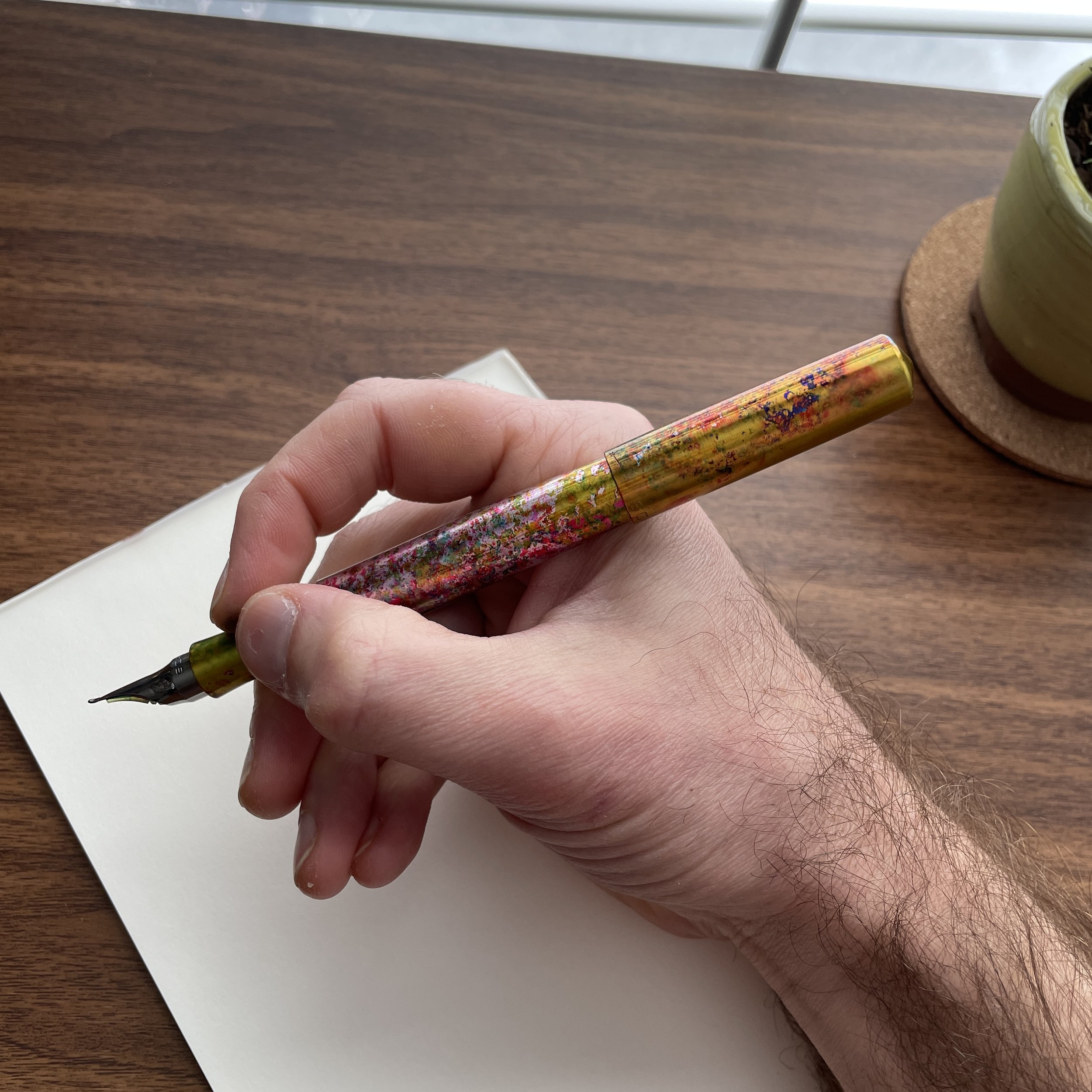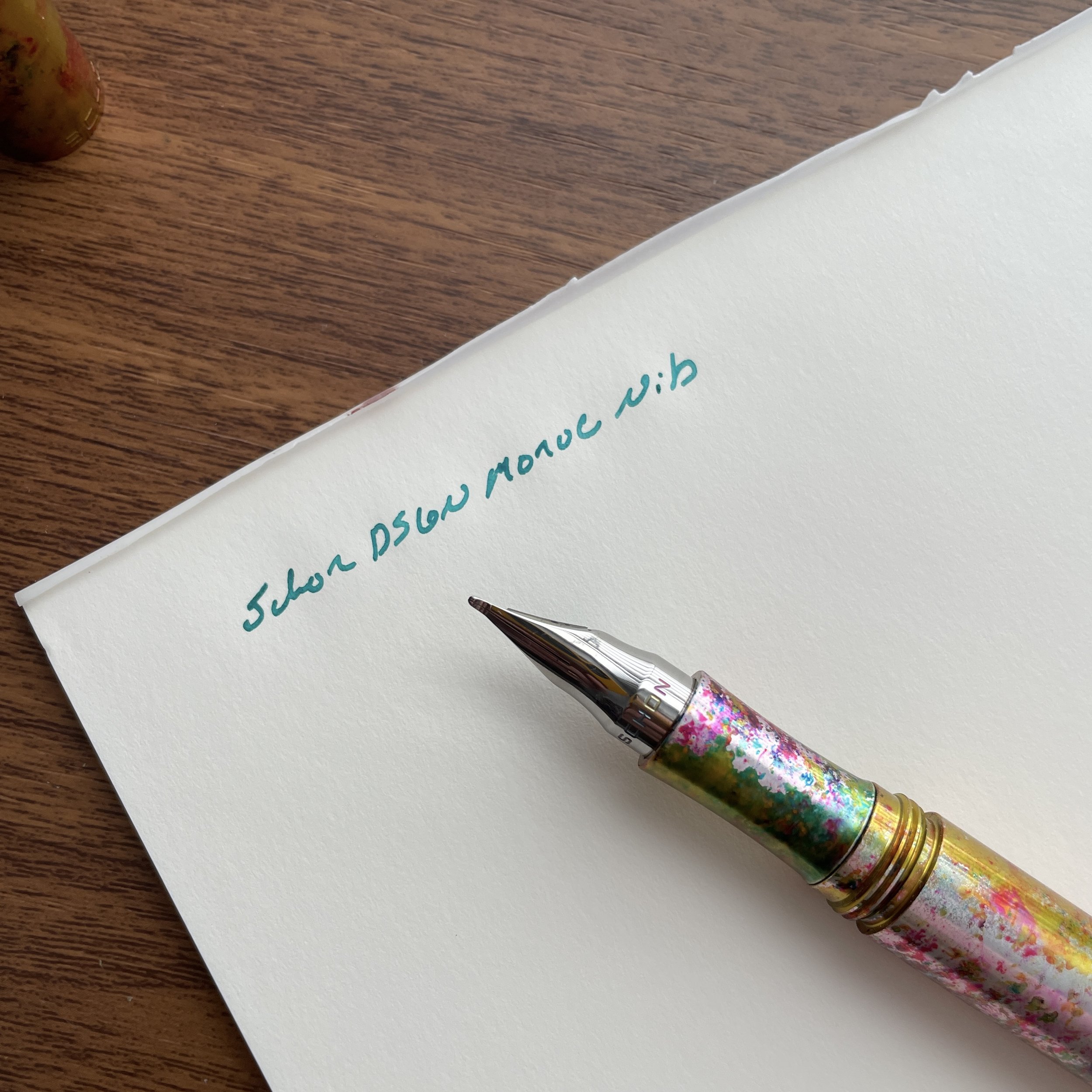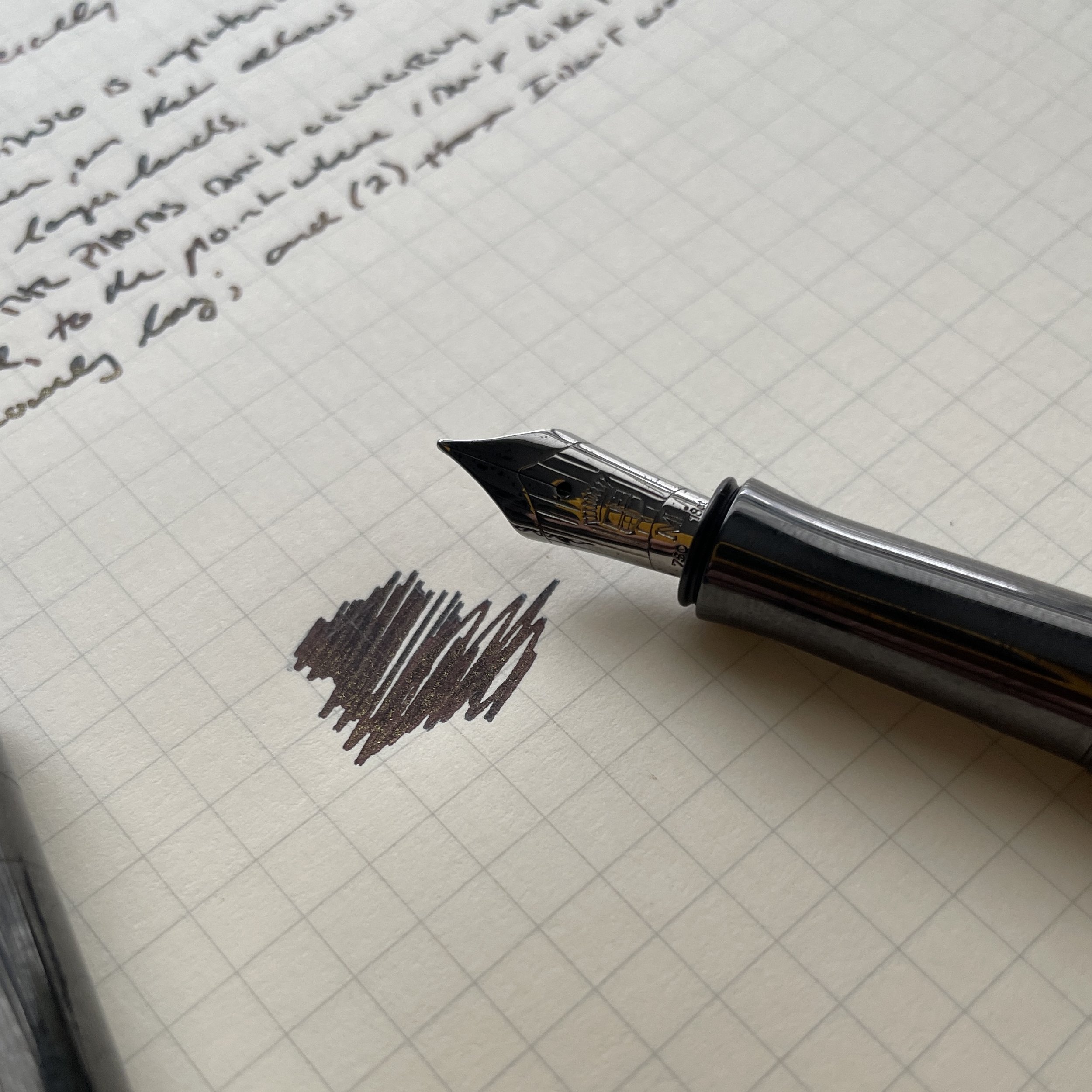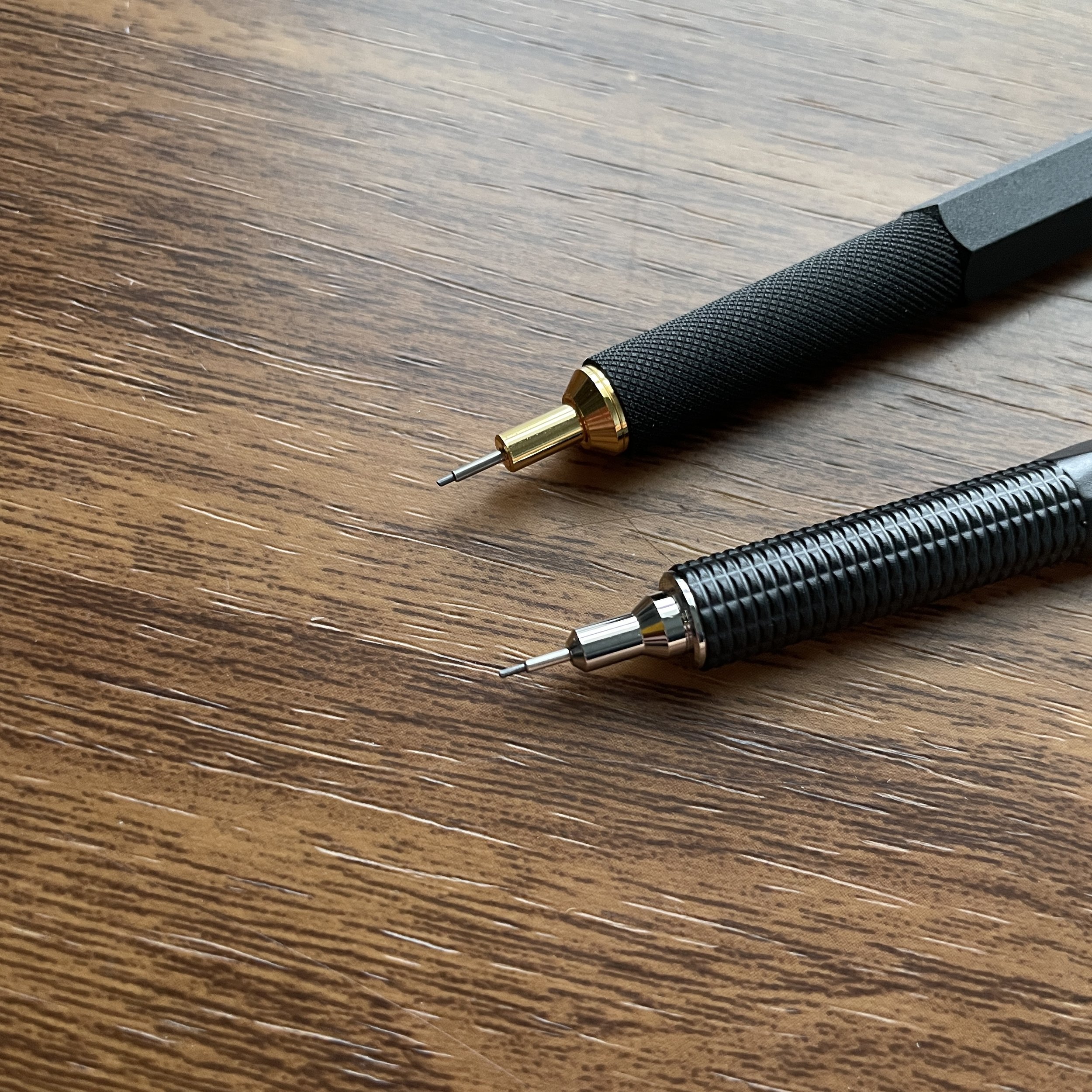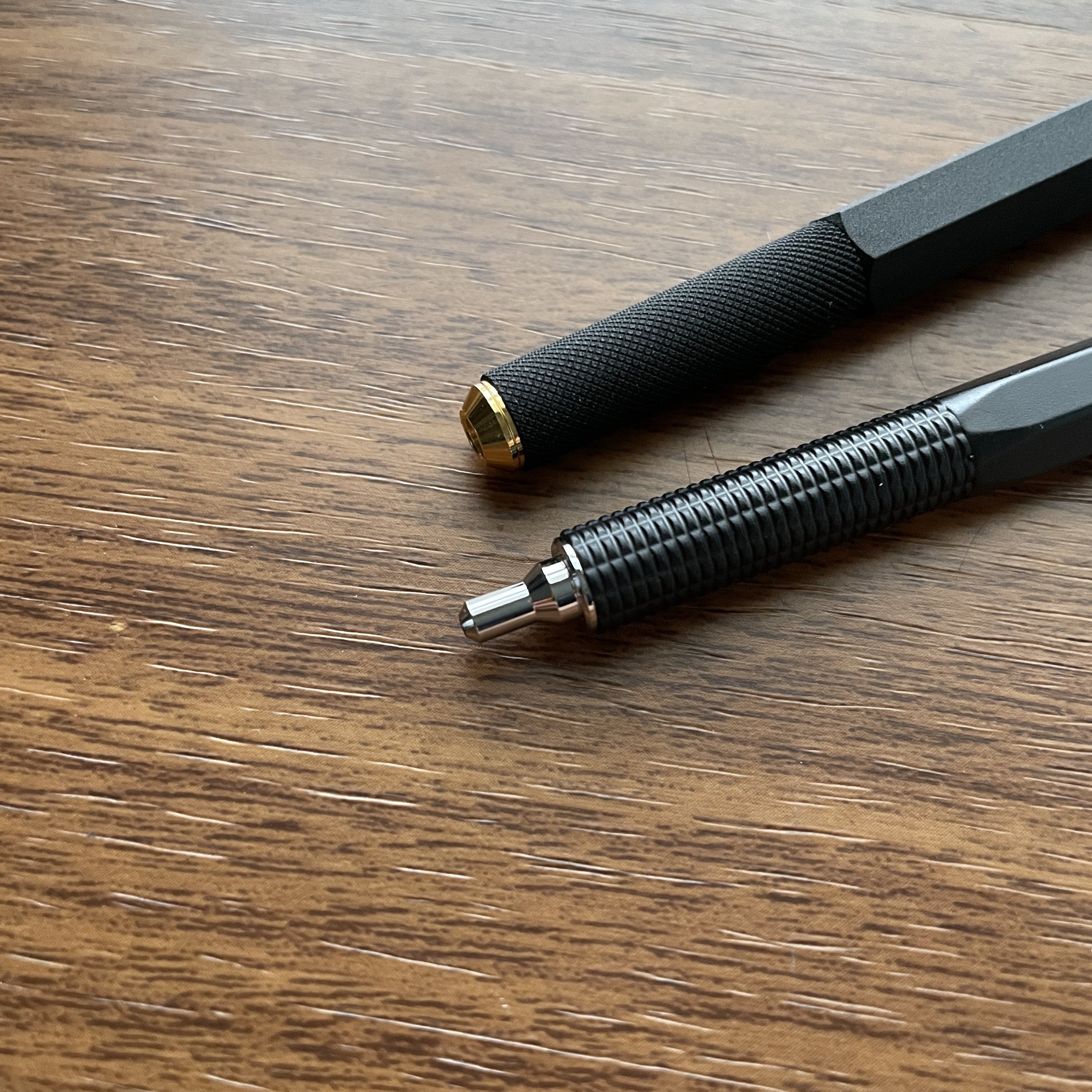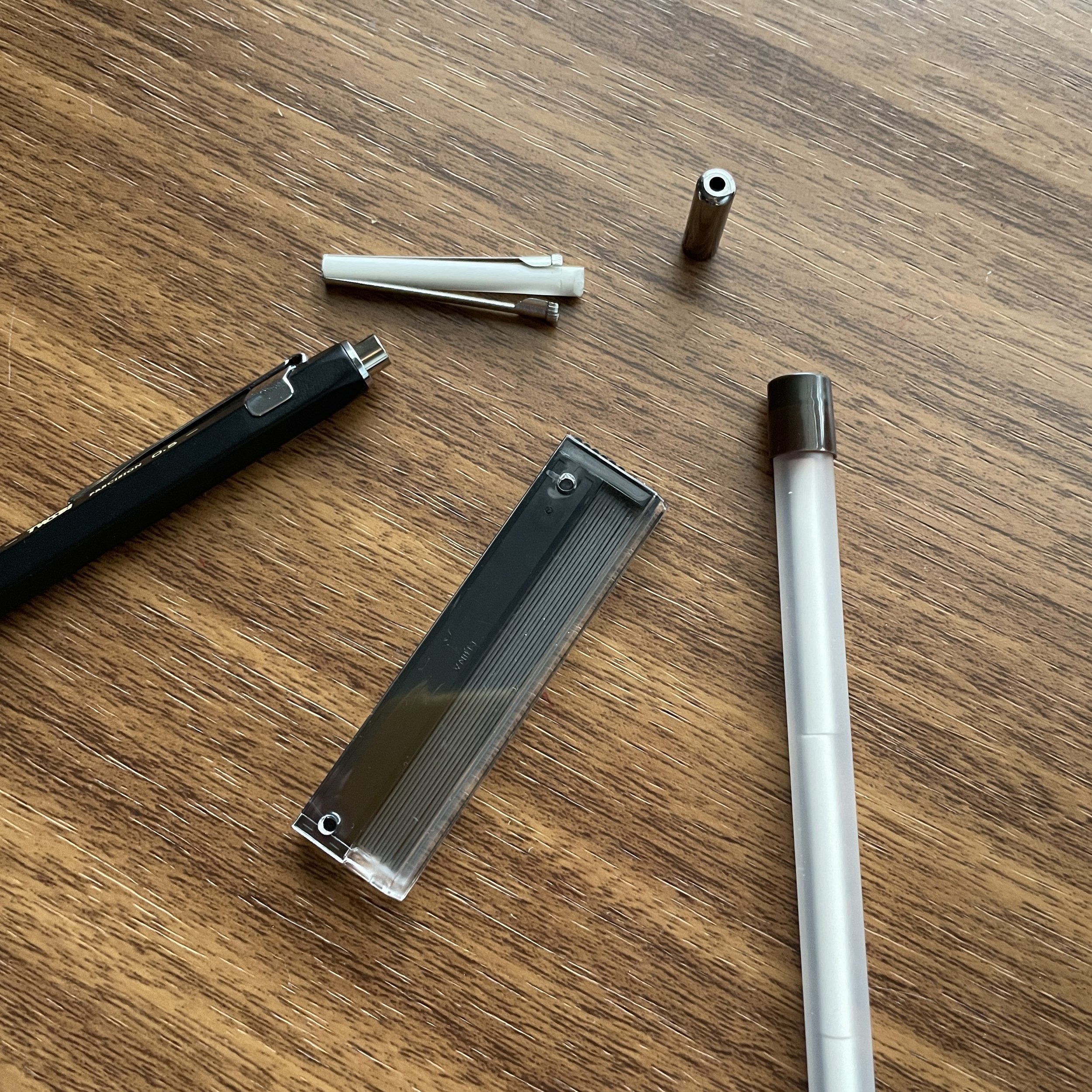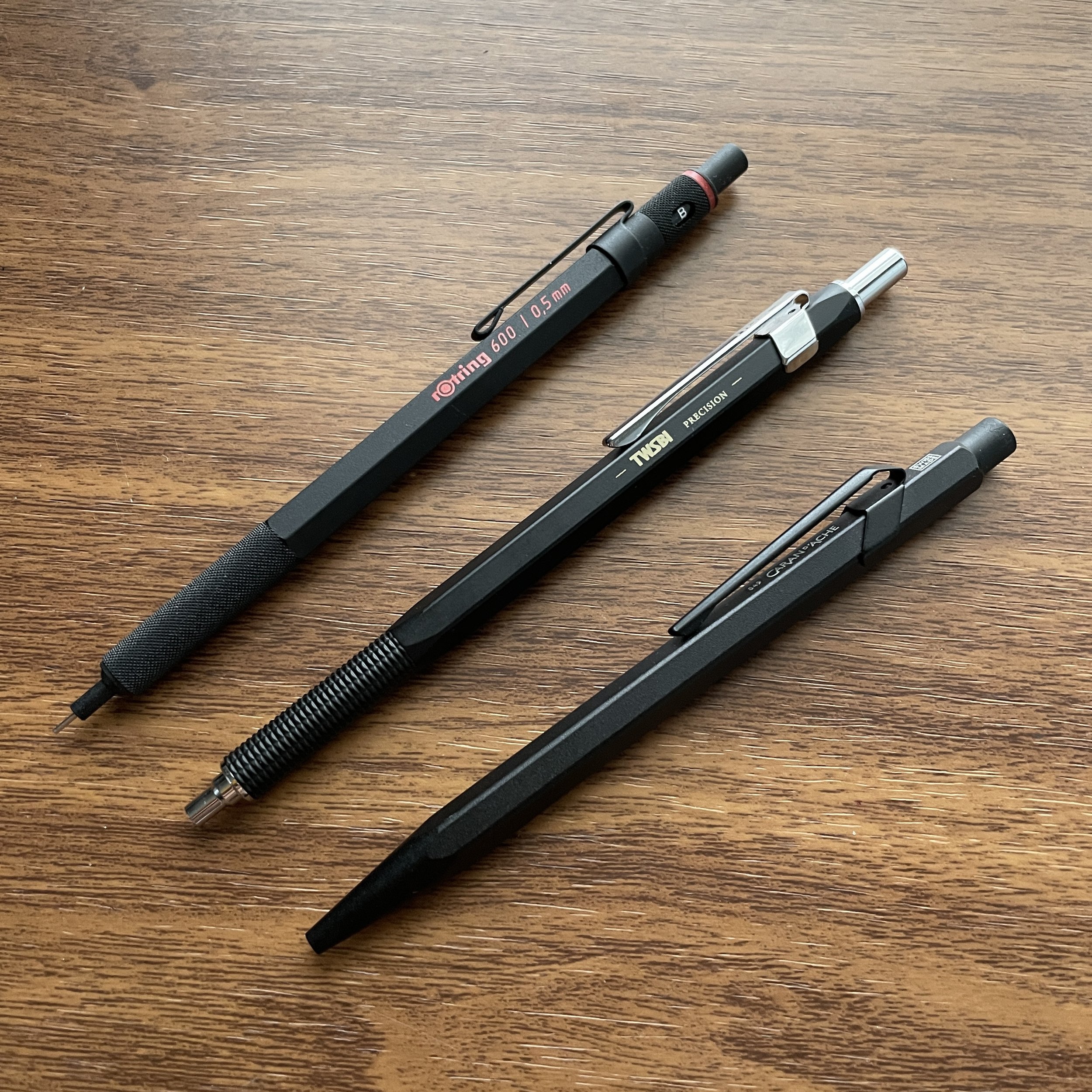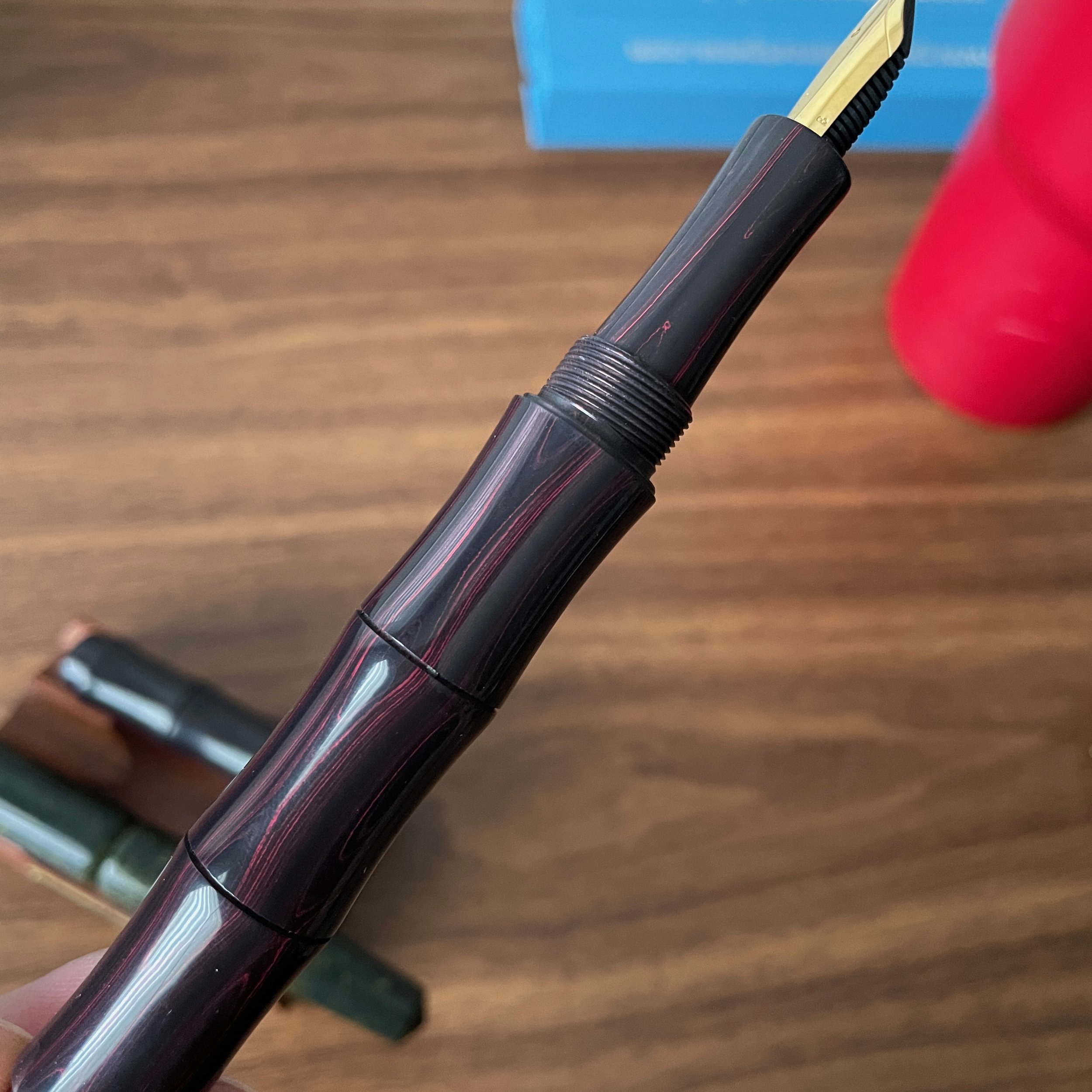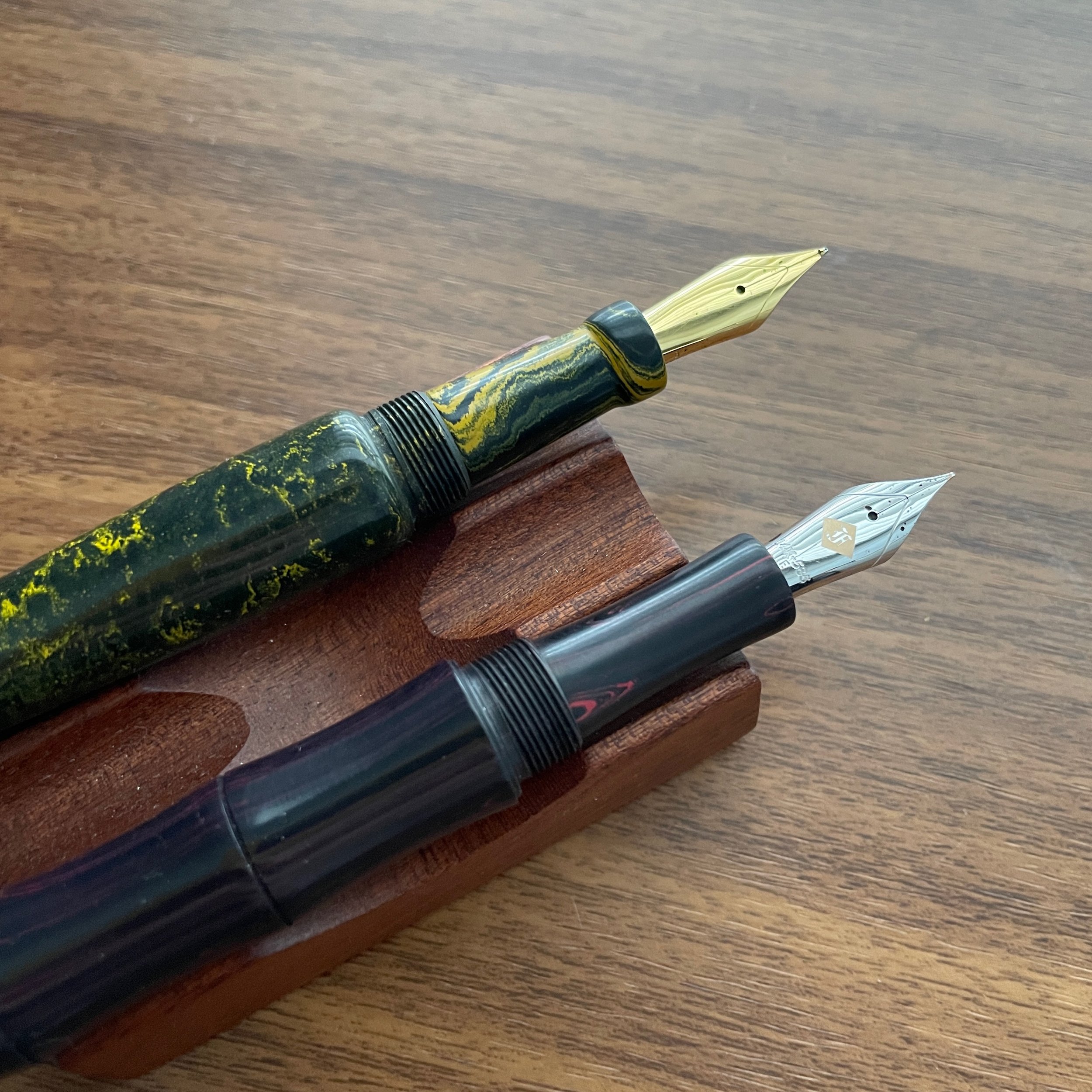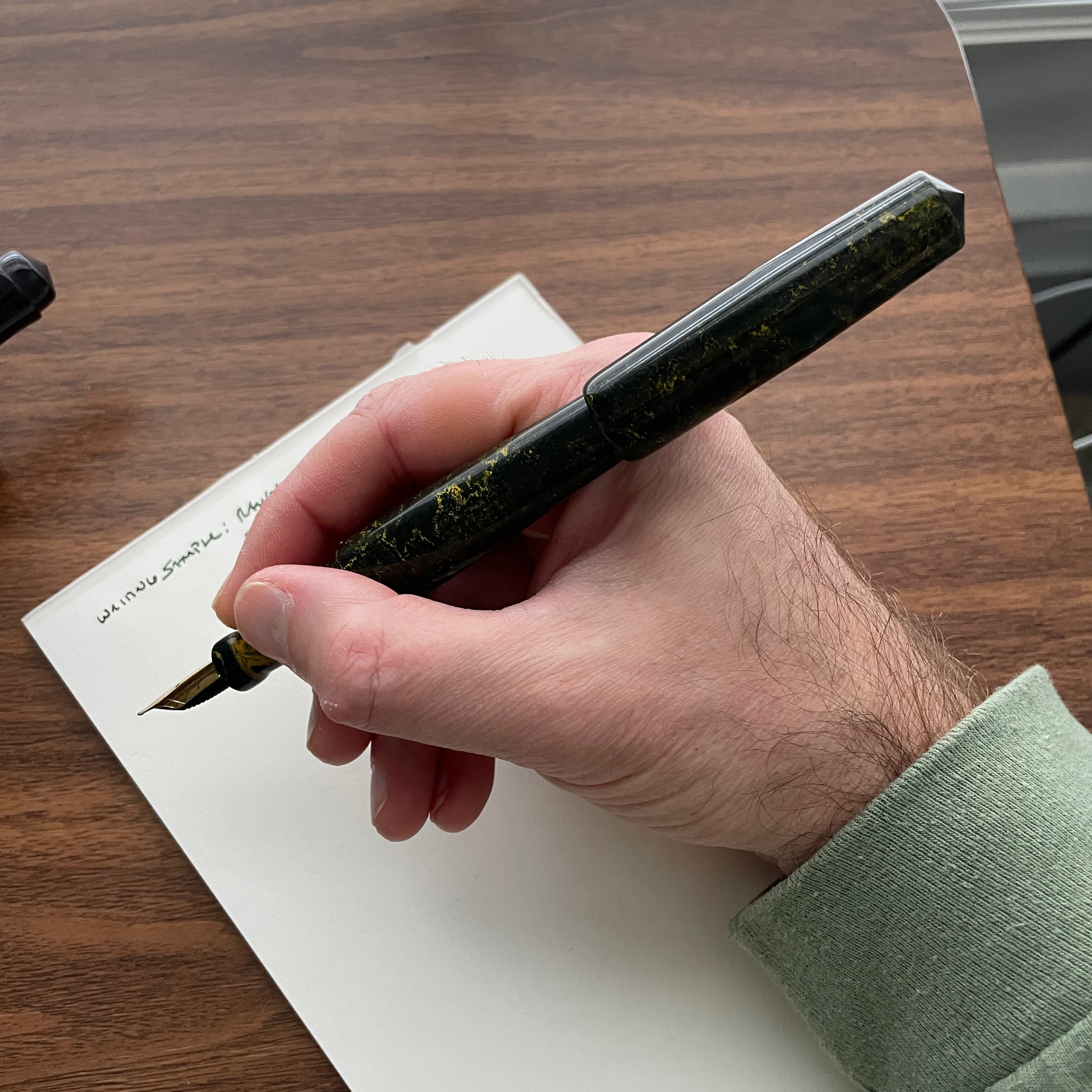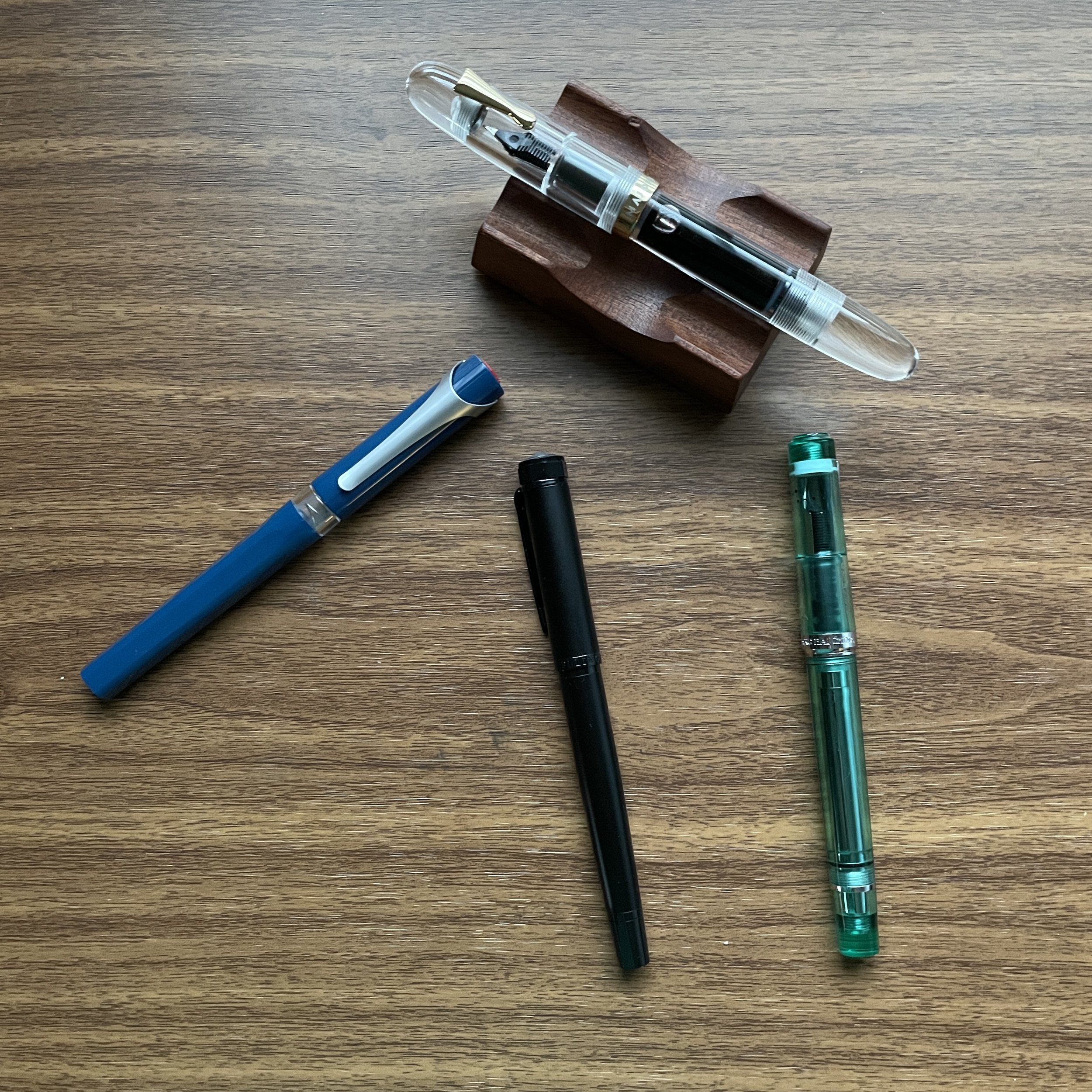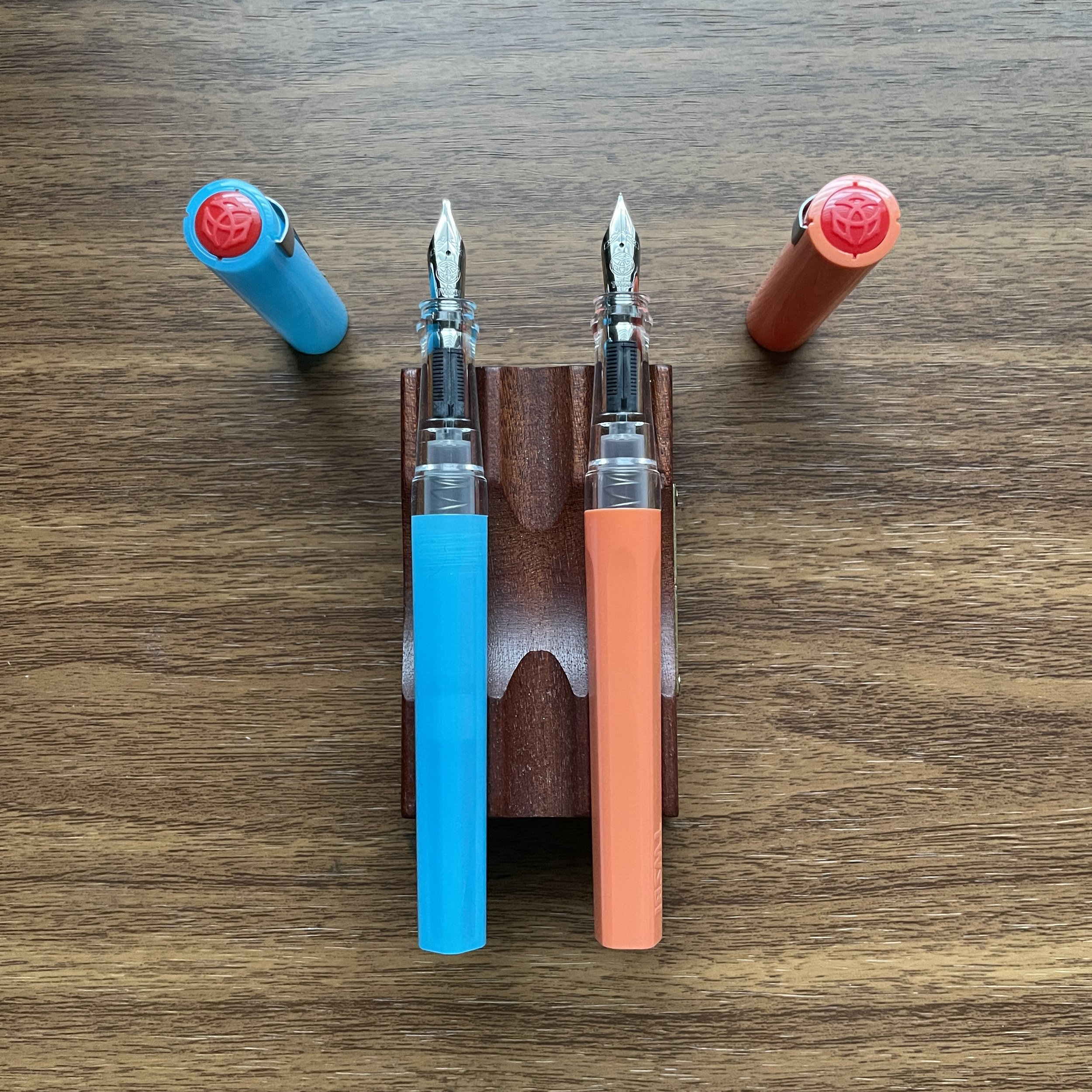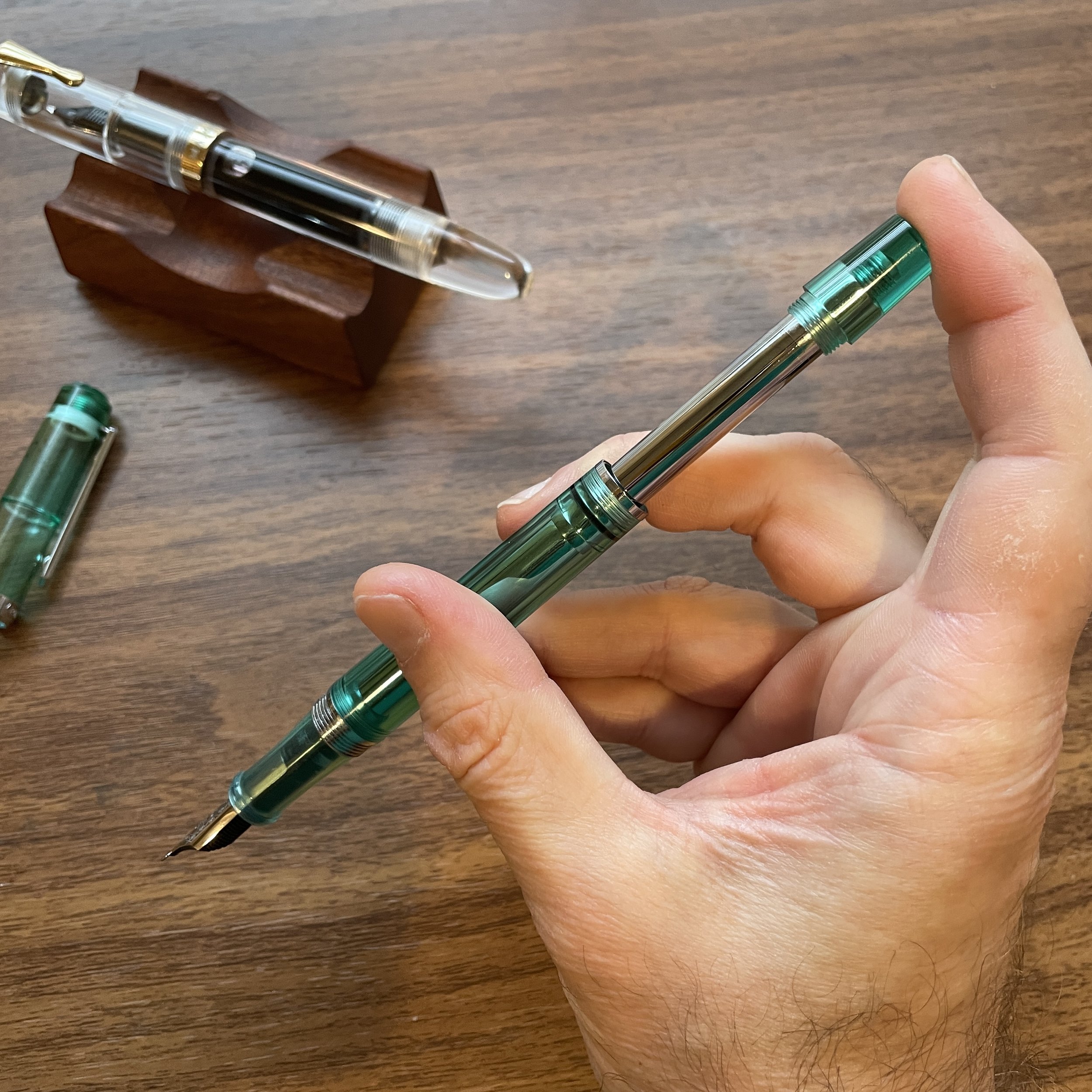For a fountain pen that’s been available for a couple of years now, the Schon DSGN Full-Sized Fountain Pen has gone a conspicuously long time without a T.G.S. review. There’s a couple of reasons for that. First, the fountain pen itself, from a purely functional perspective, is fairly similar to the Ultem and Peek “Engineered Plastics” fountain pens, which I’ve already reviewed. Second, I’ve known for several months now that Schon DSGN’s in-house Monoc nib was on the cusp of release, and given that the Full-Sized Fountain Pen serves as the main platform for both Schon DSGN’s wild anodizations and the new nib, I wanted to hold the review until I had samples of each to show you. Here goes!
Each Full-Sized Fountain Pen comes with an emoji. If you visit the Schon DSGN table at a pen show, you might have several to choose from!
The Full-Sized Fountain Pen Is a Perfect Platform to Showcase Different designs
There are certain pen brands that people consider highly collectible. Franklin-Christoph comes to mind, with a lineup of classic shapes made available in different “prototype” finishes at pen shows and limited online events. Schon DSGN has taken a similar approach with the Full-Sized Fountain Pen, using a standard shape and machined aluminum body as a platform for showing off a wide range of anodized finishes that cycle in and out of stock in the same way the Pocket 6 fountain pens do. The Schon DSGN table is a popular stop at pen shows, and I always encourage show attendees to visit the table in person if they can before making a selection online, because many finishes look completely different in person - nearly always for the better - as opposed to viewing them online. Plus you can select your emoji!
While I typically love a matte finish on a metal fountain pen, my latest addition - ‘80s spraypaint-style “Rainbow Sprinkles’ - is growing on me and might just become my favorite!
Currently, I have three Full-Sized Fountain Pens in my collection. If you’ve read my reviews of the Ultem and “Peek-a-Boo” models, you’ll know that I’m a fan of the shape, and especially the hourglass-style section which is insanely comfortable for long writing sessions. These metal pens, however, really show off the skill of Ian Schon and his team. Despite being heavier than the ultra-light Ultem and Peek, you don’t lose any of the comfort or balance in moving to the aluminum body. Some might actually find the heavier body more comfortable to use, even when posted, because the weight adds balance. (Since there’s an o-ring inside the cap, I haven’t noticed any wear from metal-on-metal contact while posting, but post at your own risk.)
First Impressions: The Schon DSGN Monoc Nib
Next up: the recently released “Monoc” nib! I’ve had my Monoc for a few weeks now, and have written through a couple of fills, so I feel comfortable offering first impressions. On the whole, this is a tremendous accomplishment by Ian and his team. What they have done is design and manufacture not just a nib, but a complete nib unit - nib + feed + housing - completely in-house, using materials and techniques not commonly used in nib manufacture.
The Monoc is machined from a single piece of Grade 5 titanium, meaning that the nib, collar, housing, and tip are all integrated into a single piece of metal, hence the name “Monoc.” From the Schon DSGN blog:
“The name Monoc being short for Monocoque - mänəˌkōk- French for ‘single shell’, often used in aerospace and racing applications where the structural body and external shell of a vehicle are made from one solid piece.”
There have been several attempts at similar nibs, most famously the Parker T1, Pilot Myu, and Pilot Murex, which remain coveted items among rare pen enthusiasts. Though not exactly the same (the Monoc is a nib unit that technically isn’t integrated into the pen body itself, and can be swapped into any JoWo-compatible pen), these nibs all offer the same extremely tactile, direct feel that is hard to describe and, at least with the Monoc, is derived from the fact that you are writing on the nib itself and not separate tipping material welded to the nib. Made from Grade 5 titanium, the Monoc is not a “springy” titanium nib like the Bock nibs that are so widely available; I find it quite stiff and you won’t get line variation via additional pressure. So why choose this material? Again, let’s look at what Schon DSGN said in their announcement post:
“With our unique approach of machining the nib from solid stock, we opted to utilize the properties of the Grade 5 titanium to create an integrated nib tip rather than welding additional tipping material onto the nib. This integrated nib tip allows for closer control of the geometry of the tip and writing surface, while the titanium offers a soft graphite-like quality that is a great writing experience. To achieve this specific writing quality, each nib is hand finished, assembled, ground, and tested to ensure it is ready for use. Due to the additional nib tip thickness of our design, the Monoc Nib is very friendly to customization as well. While some traditional fountain pen users may be uncomfortable with the idea of an integrated titanium tip, we feel the Grade 5 Titanium we use offers plenty of durability which negates the need for harder tipping material.”
Schon DSGN Amber Ultem feed (featuring turquoise ink), with the Star emoji to signal that it’s from the first batch of Monoc nibs. I believe each run will have a different symbol.
There’s a lot to unpack here. First, obviously a LOT of work has gone into the design and manufacture of this nib, from the shape of the nib unit itself to the “geometry” of the tipping. If you look closely at the tip of your Monoc, you’ll notice that it’s been carefully shaped into a slightly upturned writing surface that to the naked eye appears almost architect-like. You can’t do this via machining - each nib has to be hand finished via a process that involves grinding, tuning, and polishing, which of course increases both manufacturing time and the overall cost. Recognizing that the pen enthusiast willing to shell out $400+ on a nib like this one might also prefer to have the nib ground, Schon DSGN apparently took this into account when engineering the thickness of the tip.
A close up of the Monoc’s tip. You can see how well-polished it is, and the work that went into shaping the Grade 5 titanium.
The second point relates to durability. Titanium is softer than other metals (like iridium) typically used to tip fountain pens. That means eventually it will wear down, but the rate at which Grade 5 titanium - more durable than most - will actually wear remains to be seen. Someone who purchases the Monoc as their only fountain pen and writes with it for hours every day over a period of years might find this something to consider. That said, I find it hard to believe that this pen’s target audience - hard core fountain pen fans who likely have multiple pens they are using at any given time - will use this nib enough to have to worry about the titanium tip degrading. But again, we will have to see. The Monoc is an experimental design that likely will go through many iterations in the next year or two, based on real world user feedback.
A writing sample, showing a medium to fine-medium line with Laban Poseidon Blue on Midori MD Cotton paper.
Personally, I’ve enjoyed writing with my Monoc nib. The purchase was a no-brainer for me, ever since I first had the chance to write with this pen at the 2022 D.C. Pen Show. Currently, only one nib size is available, and I would call mine a fine-medium, understanding that the exact tip size and line width will vary slightly given that these nibs are hand-tuned. Schon DSGN made the decision to use an ultem feed as opposed to plastic or ebonite, an interesting choice from both an engineering and a design perspective. Of course I opted for amber ultem, since I’m a fan of transparent feeds. So far, the nib and feed have functioned well with the inks I’ve tried, writing what I would consider a medium-wet line. I’ve heard other reports of Monoc nibs writing wider and wetter than mine, but I’ve also been using somewhat drier turquoise inks so I’ll need to report back, which I plan to do anyway after a longer period with this nib in rotation.
Rainbow Sprinkles + Schon DSGN Monoc Titanium Nib with rainbow lettering.
Takeaways and Where to Buy
I consider Schon DSGN to be one of the more innovative penmakers working today, pushing the envelope in terms of what can be done in literally every aspect of pen making, whether it’s the design of the pen body, the design of the nib, or materials and anodized finishes. While their pens aren’t inexpensive, I personally consider them an insanely good value given the quality and the work that goes into them.
The Monoc (center) shown with two different Steel No. 6 JoWo nibs. The Monoc’s slimmer, tubular design transforms the look of the Full-Sized Fountain Pen.
A Schon DSGN Full-Sized Fountain Pen with a standard JoWo nib (not the Monoc) will run you $195, well within the current range of reasonableness for products from a smaller, independent manufacturer. On the Monoc, cost will present an issue for many people. For the initial launch, Schon DSGN has priced the Monoc at $400 USD, which includes not just the nib but a matte black Full-Sized Fountain Pen. (You can change the pen color to a finish of your choice for an extra $100.) That’s a lot of money, sure, but for what it is, I don’t consider this product “expensive.” There are plenty of companies out there trying to push the $400-500 envelope with less innovative pens (including some with generic JoWo or Bock nibs), so this price point for a completely in-house titanium nib actually strikes me as fairly reasonable, especially when you factor in the work involved on each individual piece and the fact that the nibs are currently made to order. The Monoc represents the kind of innovation that I’m happy to support.
Note: I purchased the Monoc nib and Schon DSGN pens featured in this review with my own funds. Pens can be purchased directly through the Schon DSGN website. Please be aware that the Monoc nib is a “made-to-order” product. These nibs are assembled and hand-tuned in small batches, by a small team, so if you place an order you are committing to purchase one, with a 15% cancellation fee if you change your mind. This is plainly disclosed on the order page.
The Gentleman Stationer is supported entirely by purchases from the T.G.S. Curated Shop and pledges via the T.G.S. Patreon Program. This post does not contain paid affiliate links or advertising.

